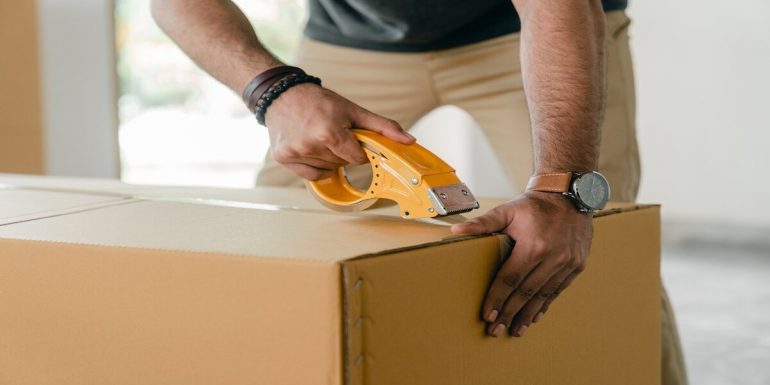Finding a new house can be challenging, but once that’s out of the way. Packing your entire house is the next thing you have to deal with. Although moving can be an exciting and thrilling adventure or phase. But it’s also a daunting and stressful task.
According to Medium’s survey, out of 1,000 respondents, 48% claimed that packing their belongings is the most stressful and challenging part of moving.
When you pack, you’re forced to get out of your daily routine. And spend more time gathering and packing your entire house. Furthermore, packing isn’t only about putting everything inside the boxes.
It’s also about determining what to pack, where to begin, how to pack oddly-shaped items, move or lift objects, and much more. Hence, the success of your packing endeavor highly depends on your preparation and proper planning.
Fortunately, this article can serve as your guide to packing your entire house smoothly without going into a frenzy. So, read below for some great packing tips to help you make moving easier.
1. Eliminate everything you don’t need in your new home

As mentioned, moving can already cause stress and even depression. When movers pack too many belongings, this may cause additional stress. Hence, to lessen the pressure, it’s best to determine what you plan to take with you in your new home.
At the same time, use this time to assess and eliminate unnecessary, excessive, old, or broken. Packing things you don’t use will only add more clutter in your new home, preventing you from having a fresh start with a clean slate.
In addition, if you live with family members or friends, you can assign them to their bedrooms and let them declutter and remove the things they won’t pack out of the house. You can segregate these into three groups: donation, sale, and disposal.
Things for donations and sale should be items that are used but still in good condition. Meanwhile, if you’ve collected damaged, broken, or unusable items, you may prepare them for proper disposal.
Ultimately, decluttering and removing things you don’t need will do the packing and moving more manageable and much lighter.
2. Hire a reputable moving company
Most often, some assume that moving companies are only hired when you need help moving and lifting your boxes, furniture items, and other objects.
But the truth is, most moving companies offer additional services, including short- or long-term storage options, overnight truck storage, and packing services.
So, if you’re moving alone or don’t have enough time to go through the whole packing process, consider hiring a moving company that offers packing services.
When you do so, they can help you organize and pack up your items, especially the difficult ones. You can also choose whether to hire their full-packing service or only avail of their packing supplies. Either way, hiring a moving company can help ease packing your entire house process.
3. Gather the necessary packing supplies

Before you start packing, it’s recommended that you gather all the packing supplies you need in one room. This way, you wouldn’t waste time running to the store multiple times to grab some packing supplies you’ve missed.
Here are some of the vital packing supplies you need for your move:
- Boxes: Boxes are the most useful items when it comes to packing. If you hire a moving company, they can provide you with high-quality packing boxes in various sizes, which you can use for your packing. Meanwhile, if you’re unsure how many packing boxes you need, you can use a packing calculator or moving box calculator to calculate and have a more accurate estimate of the number of boxes you need.
- Packing tapes: Gather as many packing tapes as possible, so you do not need to worry about running out of tape while in the middle of packing. Also, go for high-quality ones, as some packing tapes may be cheap, but they won’t be reliable in holding your boxes together.
- Scissors, utility knife, or box cutter: Have a sharp pair of scissors, utility knife, or box cutters prepared for packing and moving. Aside from being used to cut various things like packing tapes, boxes, etc., they’ll also be the first things you’ll need once you need to reopen and unpack some boxes.
- Permanent marker: You can exchange pencils and pens for thick permanent markers. Your marker must be no less than a 4 mm ball-tipped marker and no thicker than 5 mm chiseled-edge markers. Thick markers will be much easier to read and recognize even from afar.
- Bubble wraps, newspapers, blankets, and paper towels: These things can be helpful for additional padding when wrapping items, especially fragile and breakable ones.
- Heavy-duty trash bags: Although trash bags are initially for collecting garbage, you can also use them as an alternative in case you run out of boxes. For example, if you have extra clothes that you haven’t packed, you can put them in the trash bag. If you have some linens, random pillows, or cushions, you can also put them in the trash bags.
Remember that you don’t need to buy all these. You can be resourceful and ask for used boxes from your family or friends or recycle the ones you have at home. This way, you can save money and spend it on other materials you may need.
4. Start packing as early as possible
It’s recommended to start packing your entire house at the earliest time possible to have more time to sort out your things and plan your packing accordingly.
For example, if you’re scheduled to move during summer, you may pack your winter coats, holiday decorations, and other winter-season items. This way, your winter-season boxes will be ready to go when the actual moving day arrives, minimizing stress.
5. Have a packing station

Ideally, you can choose a room or particular space serving as your packing station or room. This space is where you’ll gather and keep all your packing supplies and store all the boxes after filling them up with your stuff.
This is also where you and your family can gather whenever you’re scheduled to pack your things. That way, while you’re all busy packing, you can keep the house’s harmony instead of scattering your boxes and packing supplies all around, which can be chaotic and disturbing.
6. Start from the least-used room
Now that you have the packing supplies and a packing station, you can begin packing. It’s best to start at the least-used room in the house, like the attic, garage, basement, or guest room.
Since these rooms are rarely used, you can go on for several weeks or months without needing to use some of the stuff from those rooms. When you’ve finished, you may move on to the next least-used rooms or skim the non-essential items from the most-used rooms.
As the moving day is approaching closely, you may start packing from the busiest rooms like the kitchen, bathroom, or bedroom. Begin with the kitchen and pack away the kitchen tools or equipment you rarely use.
Moreover, you can leave the right amount of food and cooking utensils that you can consume good enough for the remaining days before your move. Finally, save the bedroom and bathroom for last since they have most of the items you use daily.
7. Use the right size of packing boxes

People often think large boxes are best to use for packing heavy items. In reality, it must be the opposite. When you fill heavy objects, like thick books, vases, and small coffee tables, it’s best to use small boxes.
This way, despite being heavy, the professional movers will easily lift and move them. Meanwhile, for lightweight items like pillows, blankets, or linens, you may pack them in large boxes. Don’t forget to label each box after filling it.
8. Take special care when packing the kitchen
Packing the kitchen is often the most challenging room to deal with since it contains the most fragile items. So, take special care and precaution when packing kitchen items. Here are some tips to help you out:
- Wrap each dishware and glassware in individual packing paper or bubble wrap to cushion them.
- Place the same group of glassware or dishware in one box and add plenty of paper or bubble wrap between items for added cushion.
- When packing glasses or cups in boxes, use cardboard dividers for additional protection.
- All boxes with breakable items must be labeled “Fragile.”
- All kitchen appliances—like a blender, toaster, coffee maker, etc.—must be emptied and cleaned before being packed in boxes. Wrap their wires or cords in a plastic cup before placing them inside the box.
If you still have plenty of food stock, you can donate or cook them in large quantities. Remember, it’s best not to bring perishable food and other consumable products during the moving day to prevent spoilage
9. Deal with the bedroom and get your wardrobe in order
There are several options on how you can pack your clothes for moving. You may fold and put them in suitcases, cardboard boxes, or trash bags. You may also leave them in your dresser, provided it isn’t too heavy to move.
As for your footwear, there are various ways to pack your shoes. You can wrap your shoes or footwear in individual papers or plastic bags before packing them together in one box.
This is to prevent their buckles or heels from damaging other shoes. Moreover, you can stuff packing papers inside to avoid deforming them.
As for packing your linens, blankets, and pillows, you can place them in trash bags to protect them from dust. But for more oversized bedroom items—such as a bed frame, nightstands, or a dresser—disassemble them before wrapping.
10. Sort and pack the bathroom
The bathroom may be the smallest room to pack, yet it requires a lot of patience since you’ll need to go through every cabinet and drawer to decide which ones to throw and pack.
Whatever you choose to fill, ensure all their lids are appropriately closed by wrapping them in packing tape to avoid leaks or spills. In addition, pack medications separately and label them accordingly.
11. Keep the essentials with you
On the day before your move, pack all the essentials in one box or suitcase, including a change of clothes, toiletries, paperwork, cash, and the like. This way, you can take them with you during the travel and easily access them when necessary.
The bottom line
Packing may not be an enjoyable experience, but it doesn’t have to be stressful, either. With planning and proper preparation, you can have a smooth packing experience and reduce your risk of moving mishaps.
So, use this guide when packing your entire house. Start packing early, get help from your family, and enjoy the adventures of moving.




